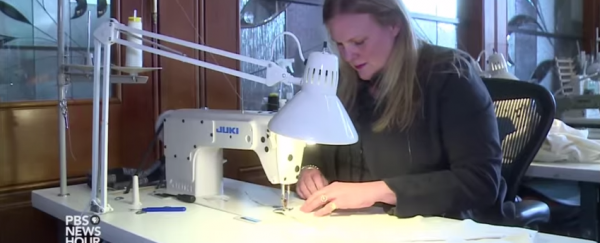The latest Ebola outbreak in West Africa has killed more than 10,000 people, including more than 200 healthcare workers. Although they wear protective clothing to try to keep themselves safe while treating infected patients, the current design has plenty of problems - not least of all the fact that it's so hot it can only be worn for 45 minutes at a time. The hooded suit relies on separate goggles and leaves large patches of skin on the face exposed, giving the virus an opportunity to invade.
But now an unlikely team of engineers, students, public health workers and a wedding gown designer have teamed up to create a better prototype at Johns Hopkins University in the US. The team formed in response to a US Agency of International Development 'Grand Challenge' - call-outs that aim to get people from all over the world to work together to solve global problems.
"It was all consuming," Jill Andrews, a Baltimore-based wedding dress designer, told PBS News Hour. Andrews helped sew the new suit prototype, which is made out of a durable synthetic material called Tyvek. "It's just about constantly solving problems and thinking about what needs to happen next."
Their final design is now being refined further will begin production in the coming months before being shipped out to healthcare workers in Western Africa, and promises to be cooler, more comfortable and offer far better protection against Ebola.
Its primary benefit is the fact that there's no exposed skin at all - the entire head is covered in a clear, plastic hood that has a ventilation channel that flows from top to bottom. This also means that it doesn't fog up - something that happens as soon as you start wearing the goggles in current suits.
It can also be worn for 1.5 hours at a time rather than just 45 minutes, as the material is much lighter and cooler. And when you do want to take it off, the risk of contamination is far less as the zip is at the back of the suit, and you never have to touch it - you simple hook straps on the sleeves onto your shoes and stand up, pulling the while thing off.
The team came up with this design after using chocolate syrup to model how bodily fluids could spread and get onto the wearer's skin.
"You rub the stuff all over yourself and then try to take off the suit and then see if any of it got on your skin," Youseph Yazdi, from the Johns Hopkins University Centre for Bioengineering, Innovation and Design, told PBS. "It's a poor man's simulation."
USAID believes this collaborative approach to problem solving is the way of the future, and they're not the only ones - with organisations like the Gates Foundation putting out similar calls to action to attract thinkers from all walks of life to create better condoms and help improve water sanitation.
"The old approach of having people spend years in the lab developing stuff is great to develop new science and technology," said Yazdi. "But when it comes to solving problems, to bridging between science … and human need, this approach is really, I think, a very good one to take."
We couldn't agree more. Bring it on.
Watch the full PBS report below:
Source: PBS News Hour

